A mountainous, strikingly diverse and beautiful country wedged between Colombia and Peru on South America’s Pacific coast, Ecuador has every type of ecosystem from Amazonian jungle to Andean peaks. It’s a traveler’s mecca.
Teeming with a vibrant indigenous culture, its tiny towns and ornate cities are connected by good roads crisscrossing the country’s relatively small land mass. That makes it easy to explore. And, thanks to a local community of passionate riders, the country has an amazing mountain bike infrastructure. We spent two weeks exploring with Jorge Perez, owner of Tierra del Volcan and an expert on the best trails in the country. Here’s where he took us to ride.
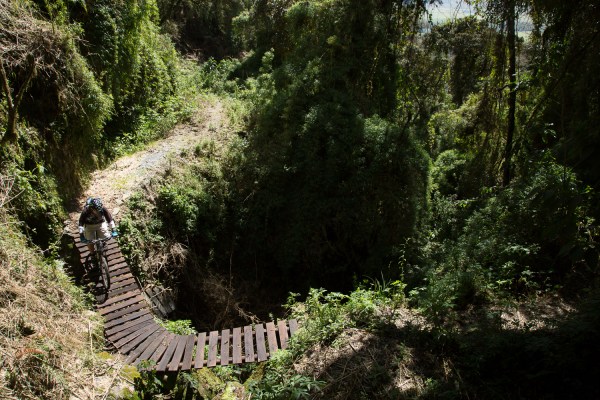
Guide “Duende” rides a purpose-built in El Pedregal Valley on the edge of Santa Rita Ecological Reserve, a few kilometers from Hacienda El Porvenir and Cotopaxi National Park. Many of the trails that mountain bikers ride in Ecuador are old trade or transportation routes. But leaders of the mountain bike community, like Jorge Perez, are building trail from cross-country to enduro, in and around Quito and beyond. Rider: Andréz Fiallo.
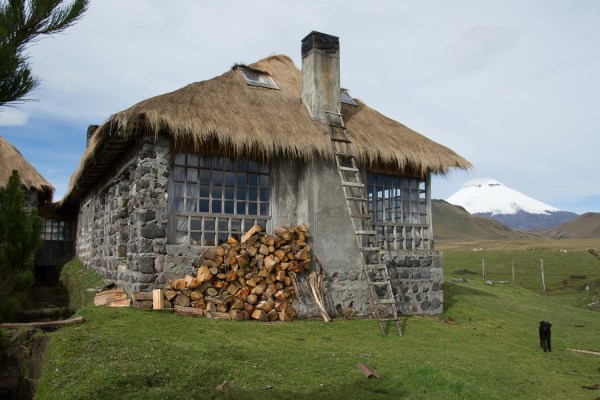
Hacienda El Tambo, one of Perez’s lodges, was built on ancient Incan foundations. The lodge, which sits in a cirque of four volcanoes, has a traditional thatched roof made from local grasses. The stone floors are covered with heavy rugs for warmth and a massive stone fireplace dominates the living room. Ride to El Tambo by bike or by horse—it’s a three- to five-hour cross-country trip over a high pass. As you travel, you’re in the constant shadow of Cotopaxi, riding past wild horses and wild bulls grazing on the altiplano.

Infernillo, “Little Hell,” begins with a massive downhill on cobbled dirt roads, then climbs into the mouth of inactive Puluahua volcano. The rollicking route takes riders through steep, rocky, handlebar-wide cuts, through stretches of moonscape, Moab-like slickrock and into grassy, cloud-forest single track. Eventually you top out onto steep, eroded hike-a-bike crossings, and finish with a two-hour climb in searing heat out of the valley where the singletrack ends.
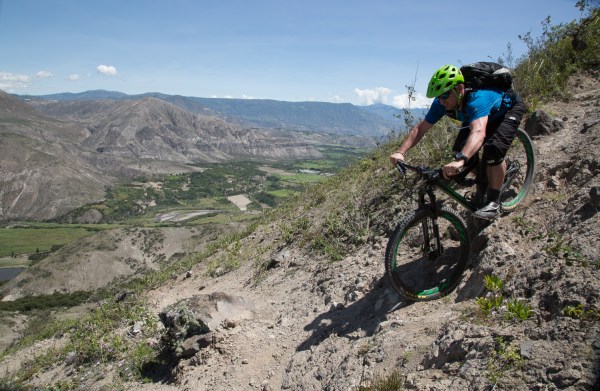
Ecuador’s ecosystem ranges from tropical jungle to high desert. In Chota the landscape is dry, with cactus growing trailside. After epic views all day of the surrounding mountains, and technical trail shared by bikes and motos, rider Louis-Julien Roy tackles the steepest section of trail as it plummets into the sandy valley below.
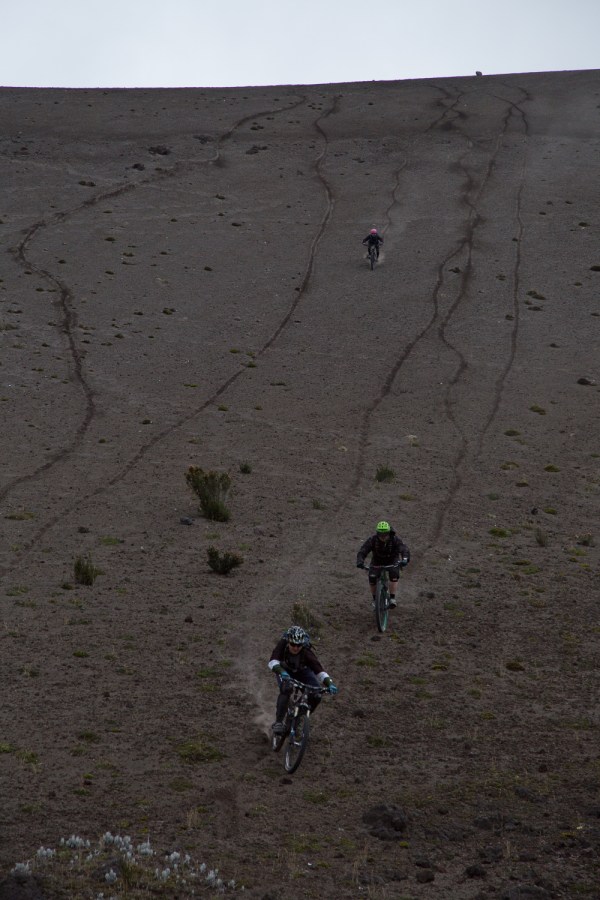
Flying 3,200 feet down the flanks of Cotopaxi is a little like snowbiking–a slightly out-of-control slide and a whole lot of fun. From the initial volcanic ash slopes, the trail gets progressively more grassy and rocky and eventually exits the mountain via a meandering canyon sprinkled with rocky rolls. Riders: Andrés Fiallo, Heather Cleveland and Luis-Julien Roy.
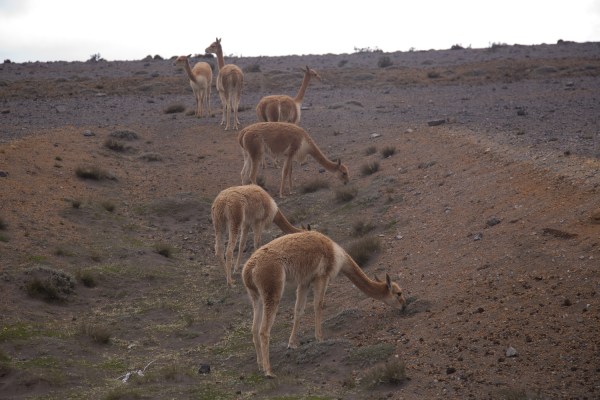
Vicuña graze trailside on Ruta de los Hieleros on the flanks of Chimborazo. This volcano on the equator is the closest point on Earth to the sun, and was the most sacred place to the Incas, who considered themselves children of the sun. Vicuña, which are related to guanacos, llamas and alpacas, live wild in the high alpine of South America, but unlike their relatives, they can’t be domesticated. Their wool is extremely fine and warm, and highly prized.
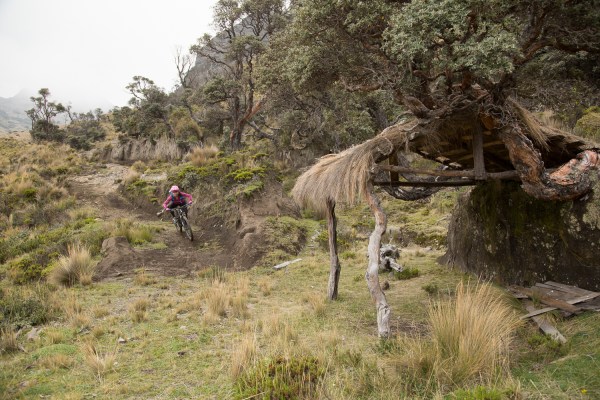
During Colonial times, men carried ice from the glaciers on Chimborazo volcano to the coast. Now, riders can pedal parts of the Ruta de los Hieleros, winding through paperbark forest and rock gardens and along cross-country singletrack through the mountains ending in farmers’ fields. Rider: Heather Cleveland.
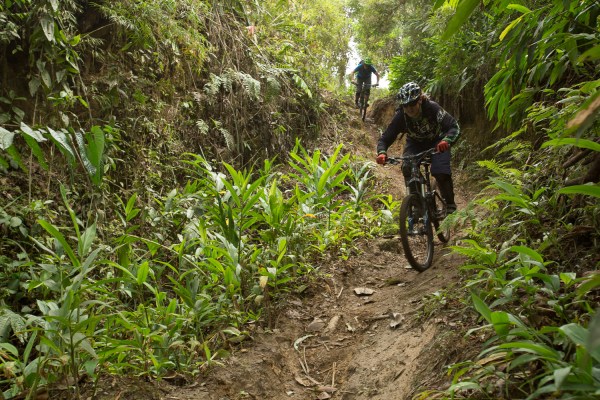
Ecuador’s most legendary mountain bike trail is Mama Rumi. Over 11 miles long, the trail plummets from 10,500 feet in Ecuador’s highlands to below 3,000 feet into a jungle of banana plantations. On the way, riders descend through high mountain forest, cloud forest and rain forest. Mama Rumi is a well-beaten track, originally used by booze smugglers to transport their hooch by horseback. Rider: Andrés Fiallo.
